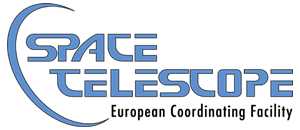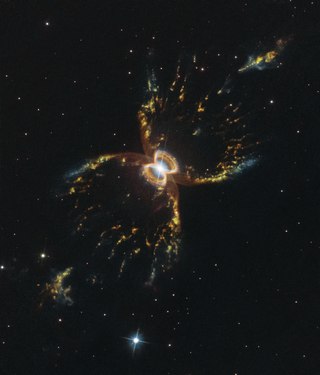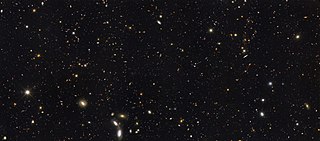
Adobe Photoshop is a raster graphics editor developed and published by Adobe for Windows and macOS. It was originally created in 1987 by Thomas and John Knoll. Since then, the software has become the most used tool for professional digital art, especially in raster graphics editing. Owing to its fame, the program's name has become genericised as a verb although Adobe disapproves of such use.

The Hubble Space Telescope is a space telescope that was launched into low Earth orbit in 1990 and remains in operation. It was not the first space telescope, but it is one of the largest and most versatile, renowned as a vital research tool and as a public relations boon for astronomy. The Hubble telescope is named after astronomer Edwin Hubble and is one of NASA's Great Observatories. The Space Telescope Science Institute (STScI) selects Hubble's targets and processes the resulting data, while the Goddard Space Flight Center (GSFC) controls the spacecraft.

A galaxy cluster, or a cluster of galaxies, is a structure that consists of anywhere from hundreds to thousands of galaxies that are bound together by gravity, with typical masses ranging from 1014 to 1015 solar masses. They are the second-largest known gravitationally bound structures in the universe after some superclusters (of which only one, the Shapley Supercluster, is known to be bound). They were believed to be the largest known structures in the universe until the 1980s, when superclusters were discovered. One of the key features of clusters is the intracluster medium (ICM). The ICM consists of heated gas between the galaxies and has a peak temperature between 2–15 keV that is dependent on the total mass of the cluster. Galaxy clusters should not be confused with galactic clusters (also known as open clusters), which are star clusters within galaxies, or with globular clusters, which typically orbit galaxies. Small aggregates of galaxies are referred to as galaxy groups rather than clusters of galaxies. The galaxy groups and clusters can themselves cluster together to form superclusters.
Flexible Image Transport System (FITS) is an open standard defining a digital file format useful for storage, transmission and processing of data: formatted as multi-dimensional arrays, or tables. FITS is the most commonly used digital file format in astronomy. The FITS standard was designed specifically for astronomical data, and includes provisions such as describing photometric and spatial calibration information, together with image origin metadata.

The Hubble Deep Field (HDF) is an image of a small region in the constellation Ursa Major, constructed from a series of observations by the Hubble Space Telescope. It covers an area about 2.6 arcminutes on a side, about one 24-millionth of the whole sky, which is equivalent in angular size to a tennis ball at a distance of 100 metres. The image was assembled from 342 separate exposures taken with the Space Telescope's Wide Field and Planetary Camera 2 over ten consecutive days between December 18 and 28, 1995.

The Wide Field and Planetary Camera 2 (WFPC2) is a camera formerly installed on the Hubble Space Telescope. The camera was built by the Jet Propulsion Laboratory and is roughly the size of a baby grand piano. It was installed by servicing mission 1 (STS-61) in 1993, replacing the telescope's original Wide Field and Planetary Camera (WF/PC). WFPC2 was used to image the Hubble Deep Field in 1995, the Engraved Hourglass Nebula and Egg Nebula in 1996, and the Hubble Deep Field South in 1998. During STS-125, WFPC2 was removed and replaced with the Wide Field Camera 3 as part of the mission's first spacewalk on May 14, 2009. After returning to Earth, the camera was displayed briefly at the National Air and Space Museum and the Jet Propulsion Laboratory before returning to its final home at the Smithsonian's National Air and Space Museum.

The Wide Field/Planetary Camera (WFPC) was a camera installed on the Hubble Space Telescope launched in April 1990 and operated until December 1993. It was one of the instruments on Hubble at launch, but its functionality was severely impaired by the defects of the main mirror optics which afflicted the telescope. However, it produced uniquely valuable high resolution images of relatively bright astronomical objects, allowing for a number of discoveries to be made by HST even in its aberrated condition.

Adobe Premiere Pro is a timeline-based and non-linear video editing software application (NLE) developed by Adobe and published as part of the Adobe Creative Cloud licensing program. First launched in 2003, Adobe Premiere Pro is a successor of Adobe Premiere. It is geared towards professional video editing, while its sibling, Adobe Premiere Elements, targets the consumer market.

The Space Telescope – European Coordinating Facility (ST-ECF) was an institution which provided a number of support and service functions primarily for European observers of the NASA/ESA Hubble Space Telescope (HST). It was established in 1984 by the European Space Agency (ESA) and the European Southern Observatory (ESO), and was located at the ESO headquarters in Garching bei München, Germany. The ST-ECF ceased operations on 31 December 2010.

The Hubble Deep Field South is a composite of several hundred individual images taken using the Hubble Space Telescope's Wide Field and Planetary Camera 2 over 10 days in September and October 1998. It followed the great success of the original Hubble Deep Field in facilitating the study of extremely distant galaxies in early stages of their evolution. While the WFPC2 took very deep optical images, nearby fields were simultaneously imaged by the Space Telescope Imaging Spectrograph (STIS) and the Near Infrared Camera and Multi-Object Spectrometer (NICMOS).
The Hubble European Space Agency Information Centre (HEIC) is a science communication office, established at the Space Telescope - European Coordinating Facility (ST-ECF) in Munich, Germany late in 1999. This initiative was taken so as to fulfil the NASA/ESA Hubble Space Telescope (HST) outreach and education tasks for the European Space Agency (ESA), as outlined in an agreement between NASA and ESA.

Lars Lindberg Christensen is a science communicator and author of a dozen books on astronomy and science communication translated to ten languages.

Hubble – 15 Years of Discovery (ISBN 0-387-28599-7) is a book that formed part of the European Space Agency's 15th anniversary celebration activities for the 1990 launch of the NASA/ESA Hubble Space Telescope. Its main emphasis is on the exquisite Hubble images that have enabled astronomers to gain entirely new insights into the workings of a huge range of different astronomical objects. Hubble has provided the visual overview of the underlying astrophysical processes taking place in these objects, ranging from planets in the Solar System to galaxies in the young Universe. This book shows the close relationship between the results of great scientific value and of eye-catching beauty and artistic potential.

The Southern Crab Nebula is a nebula in the constellation Centaurus. The nebula is several thousand light years from Earth, and its central star is a symbiotic Mira variable - white dwarf pair. It is named for its resemblance to the Crab Nebula, which is in the northern sky.

The Great Observatories Origins Deep Survey, or GOODS, is an astronomical survey combining deep observations from three of NASA's Great Observatories: the Hubble Space Telescope, the Spitzer Space Telescope, and the Chandra X-ray Observatory, along with data from other space-based telescopes, such as XMM Newton, and some of the world's most powerful ground-based telescopes.
Astronomy Visualization Metadata (AVM) is a standard for tagging digital astronomical images stored in formats such as JPEG, GIF, PNG and TIFF. The AVM standard extends the concept of Extensible Metadata Platform (XMP) headers to include useful astronomical information about the subject of the image as well as the telescope used to take the image. This ensures that relevant information is transferred with the image when it is shared with others. AVM could be considered analogous to the FITS headers associated with raw astronomical data files.

In Saturn's Rings is a large format movie about Saturn made exclusively from real photographs taken by spacecraft. Director Stephen van Vuuren used more than 7.5 million photographs and numerous film techniques to create the effect of flying through space around Saturn and among its rings. CGI and 3-D modeling were not used in any capacity to create the realistic feel van Vuuren wanted for the viewer's experience. Most of the photos were taken by various major space missions.

















